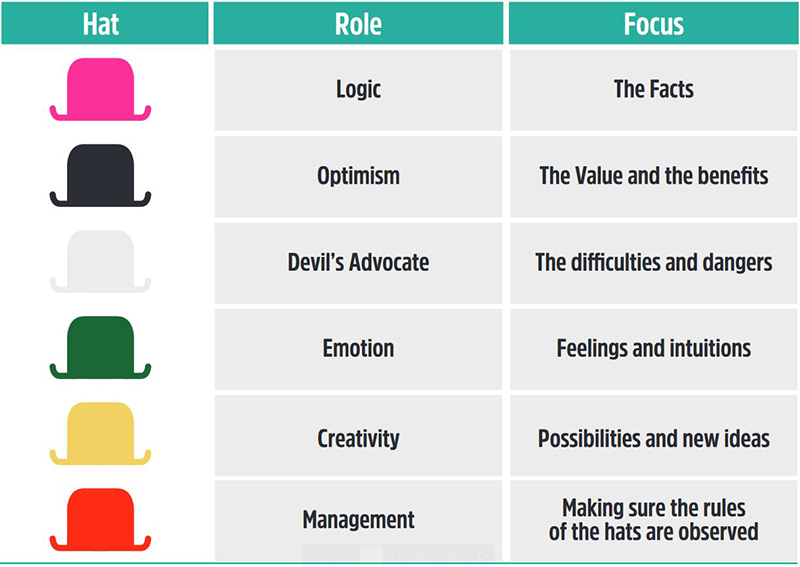Fads come and go with the times but sometimes a true fundamental tool evolves and stands the test of time. During the GenAngus presentations the participants learnt about two such tools, the ‘6 thinking hats’ and about SWOT analysis’s.
The 6 thinking hats
In all aspects of life, both personal and professional meetings and discussions can become unproductive and negative, with two possible reasons for this being communication issues and a participants inability to see multiple opinions. When communication ceases it can hinder the development of ideas or decision making and can create an negative environment.
Edward de Bono’s Six Thinking Hats method is based on the premise that everyone has the potential to see multiple perspectives or opinions. He uses hats as a symbol of perspectives, taking the emphasis away from the person (and subsequently their opinions) wearing the hat, instead giving that person the opportunity to take on the perspective of the relevant hat they are wearing. The idea being that by switching the hats around that person is able to switch perspectives.
There are 6 hats, The logical hat, the optimism hat, the devils advocate hat, the emotive hat, the creative hat and the management hat. These hats all represent a different perspective and the practice of a person either physically or mentally trying on the different hats gives that person the opportunity to think in a different way.
By using this theory, a group of people who usually hold similar opinions on a subject and have regular ‘roles’ in a collaboration are able to be pushed further to brainstorm more creative or dynamic solutions and ideas. This theory is often used as an activity to engage workers and help level the playing field of personalities in a room.
One of the main emphasises of the tool is to show that not one way of thinking is more important than the other five, you need to have an understanding of all five to have a well-rounded idea or solution, and by engaging all six you are often able to reduce conflict or halted communication in the process of creating a dynamic outcome.
See feature image
SWOT Analysis
A favorite tool for marketers, the humble SWOT analysis gives users the opportunity to identity strengths and weaknesses for the business and creates a reference point to refer to at later points to develop your strategic plan. It not only shows the strength and weaknesses of your internal operations but can help identify threats and opportunities from external influences.
Why is it important?
A SWOT analysis is often seen as one of the first steps in developing a marketing plan, and its value lies in that it is so simple to do but delivers immense value and insight.
It creates the foundation of your marketing and branding strategies.
What is it?
There are four categories that comprise of the SWOT analysis;
- Strengths: The positives – or what you bring to the table, these can be resources, knowledge, a specialized product or service or even things you do well. This is your opportunity to identify what gives you your competitive edge.
- Weaknesses: These aren’t negatives, these are things you need to focus on in order to gain a competitive edge. Highlight areas which aren’t your strongest assets, like limited technical knowledge, limited budget and resources or time constraints.
It is important to note that identifying things like your weaknesses shouldn’t put you off your goals, you should look at it as an opportunity to outsource the best help available for your needs and bring your business or venture to a whole new level.
- Opportunities: The external factors that can have a positive influence on your business, hopefully providing you with the opportunity to grow and develop. This can include opportunities for personal and professional development like the Angus Youth GenAngus mentoring program, market changes/ growth or a change in consumer habits and lifestyle changes. It is also worth considering that in an agricultural scene a good season can also be seen as an opportunity.
- Threats: These are external factors that may prove to be a risk to your venture, this can include anything from increased feed costs and drought implications to emerging technology. The biggest threat in most situations is competition.
There are free templates online that can help you map this information out in an easy to comprehend and simple manner.

One thing to remember is that the person performing the SWOT analysis can strongly influence the outcome and insights (or potentially a lack thereof), so it is recommended to have another business partner or an outside, unbiased entity like a marketing consultant or mentor review the outcomes before developing your strategic plan.
Essentially the SWOT analysis helps you identify the big picture for your business by breaking it down into smaller, easier steps.
Both the 6 thinking hats and SWOT analysis are so well received because they are simple but provide a wealth of information. These are simple breakdowns, for further and more in-depth information I suggest you have a look online or talk to a marketing consultant.


